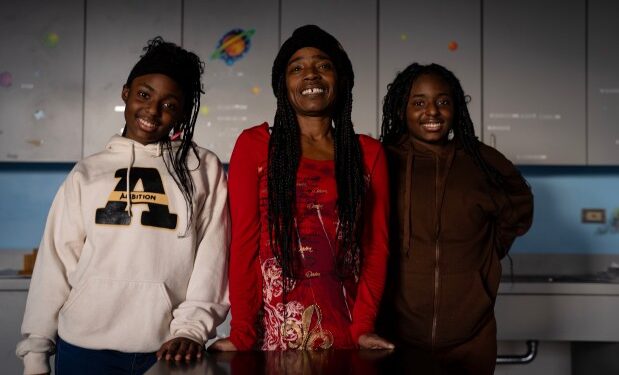In Garfield Park, Camarria Williams has often enjoyed walks with her mom. There, the 11-year-old girl also discovered a new cancer-fighting molecule in an unexpected source: goose poop.
Williams and her twin sister, Camerria, who attend William H. Brown STEM Magnet School, spent the fall of 2022 participating in a science program at a West Side Boys & Girls Club where they worked with researchers to identify potential antibiotics that occur in nature.
The twins from North Lawndale were part of the third cohort of middle school students who participated in the Chicago Antibiotic Discovery Lab, a partnership between the Boys & Girls Club and a University of Illinois Chicago lab run by pharmaceutical sciences professor Brian Murphy.
During a field trip to Garfield Park to collect samples rich in bacteria, Williams knew exactly where to look. She thought back to memories of feeding the park’s geese with her mother, she said.
“The reason I got the poop was because the goose eat everything,” Williams said.
Now 13, Williams is officially a published scientific researcher.
She is listed as a co-author on a study about the new cancer-fighting compound discovered by isolating bacteria from her goose poop sample, which appeared in a peer-reviewed scientific journal this October.
“It was an amazing experience with the Boys & Girls Club, that they can venture and learn more and go in different atmospheres,” said Antwainetta Hunter, Williams’ mother. “It is our future, children are our future. And so the goals that they’re making, I think that it is wonderful and amazing what they’re experiencing now.”
During the 14-week afterschool program, young members of the James R. Jordan Club on the Near West Side learned how to collect environmental samples, program robots and test bacteria for disease-fighting properties.
The middle schoolers not only gained a scientist’s skill set but also actively participated in the work of Murphy’s lab at UIC, which aims to identify potential antibiotics that occur in nature.

“We decided we want to involve students directly in really interesting biomedical research and try and connect each step of that research with a different career in the sciences, just to try and try and get that spark, to get them interested at an age where they should start to think about, ‘Oh wow, I could actually potentially make a career out of this,’” Murphy said.
Murphy, who launched the Chicago Antibiotic Discovery Lab in the spring of 2022, said he believes that universities have an obligation to use their resources to serve their community. Murphy’s goal with the program was to help establish a stronger pipeline to careers in science, technology, engineering and math in Chicago neighborhoods that have faced “decades” of “engineered inequity,” he said.
The program ran three cohorts of middle schoolers in 2022 at the James R. Jordan Club. After Williams made her discovery, the program ran one more time in early 2023 at the Bartlett J. McCartin Boys & Girls Club in Bridgeport, with high school students participating.
Although the initial funding has run out, Murphy said that he and Boys & Girls Club leadership have applied for new grants with the hopes of offering the program again in 2025.
Williams was one of the James R. Jordan Club’s “core club kids,” stopping by every day after school and participating in different programs, said Boys & Girls Clubs of Chicago technology program manager Jonathon Rodriguez.
Williams said she initially joined the Chicago Antibiotic Discovery Lab because it seemed like “a lot of opportunities.”
After the program, both of the Williams twins said they became interested in pursuing science in the future. Both also said their favorite part of the Chicago Antibiotic Discovery Lab was visiting UIC’s campus and getting a tour of a real-life science lab.
“We walked around and they had these chemicals, and they were working on something,” Williams said. “It was just fun.”
Williams said she preferred the Boys & Girls Club program to her science classes at school as it had more hands-on experience, adding “I just want to go out and find stuff and see what it can do.”
When she grows up, she said, she wants to be either a climatologist, a pediatrician or scientist, or a professional volleyball player.
For the West Side club, the Chicago Antibiotic Discovery program was a “real world kind of experience and exposure that our kids in our community normally don’t get the opportunity to do,” Rodriguez said.
“For Camarria specifically, to be able to say ‘Hey, you participated in this program, you gave it a shot and then it led to something that you know is going to be utilized by the scientific community,’” Rodriguez said. “It’s just a testament to mentorship and programs that really focus on providing unique opportunities and experiences to our kids … their hard work and their dedication can lead to something.”
The program was structured in order to “bring (students) along in the process of antibiotic discovery,” said Jin Yi “Jeanie” Tan, a fourth-year doctoral student in Murphy’s lab who helped coordinate the program and run key experiments. Each cohort was quite small, Tan said, with Williams’ group consisting of seven middle schoolers.
First, the students went out into their neighborhood — which for Williams was Garfield Park — to collect samples from nature, Tan said. They then worked with graduate student or postdoctoral mentors from UIC to isolate different types of bacteria from the samples and conduct tests to screen them for potential antibiotic properties, according to Tan.
For safety reasons, Murphy said, children usually are not allowed to work with bacteria during science experiments, which previously was a barrier to him engaging youth from the community in his lab’s work.
However, during the COVID-19 pandemic, Murphy’s lab was able to partner with UIC’s Institute for Tuberculosis Research to purchase a “colony-picking robot,” which could pick up bacteria colonies and transfer them onto new plates where they would be tested against a pathogen.
This robot could be “programmed from a safe place” with the young participants still “making all of the decisions,” Murphy said. Boys & Girls Club members were brought to the UIC lab to program the approximately $200,000 robot and watch it at work, Murphy said, which for some was their “first time ever going to a college.”
At the end of the program, the students were taught “how to analyze bioinformatics data” so that they could each choose which of their bacteria colonies “look promising” and should theoretically be prioritized for future research, Tan said.
“For Camarria, she prioritized the bacteria with antibiotic properties,” Tan said. “So I followed up on the strains that she prioritized, which is where in the lab I would grow it up and purify the compounds and then do some further testing. And that’s where we found this new compound that had some cytotoxic activity against cancer cell lines.”
The bacterium that Williams isolated and selected from her initial goose poop sample contained a cancer-fighting molecule that had never been documented before, according to Murphy. The lab’s partnership with the Boys & Girls Club had yielded “high-end biomedical research that was actually publishable,” he said.
After over a year of research conducted by Tan and other UIC scientists to determine the structure and properties of the new compound, the scientists wrote a paper on their findings that was published on Oct. 24 in ACS Omega, a peer-reviewed journal of the American Chemical Society.
Williams is now listed by name as a co-author of the study “Discovery of New Cyclic Lipodepsipeptide Orfamide N via Partnership with Middle School Students from the Boys and Girls Club.”
When she found out about the significance of her own discovery, Williams said she was happy that “I did something that did work.” She has a paper copy of the journal with her name inside.
Listing Williams as an author “wasn’t charity,” Murphy said, but rather followed his lab’s own policies.
Murphy’s students need to fulfill two of three criteria in order to be listed as a co-author on a study: physical lab work, intellectual input or participation in writing the manuscript. Williams had checked the box for the first two of those requirements.
“It was Camarria’s intellectual input that chose the goose poop,” Murphy said. “None of us would have thought to do that, and she did it.”
Originally Published:







